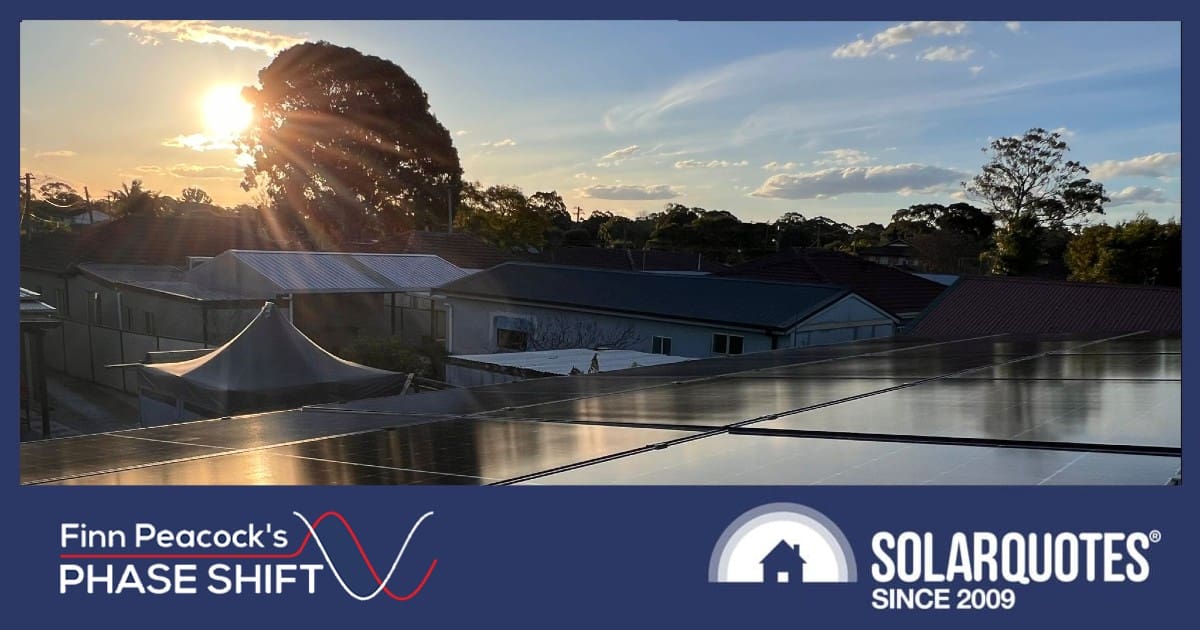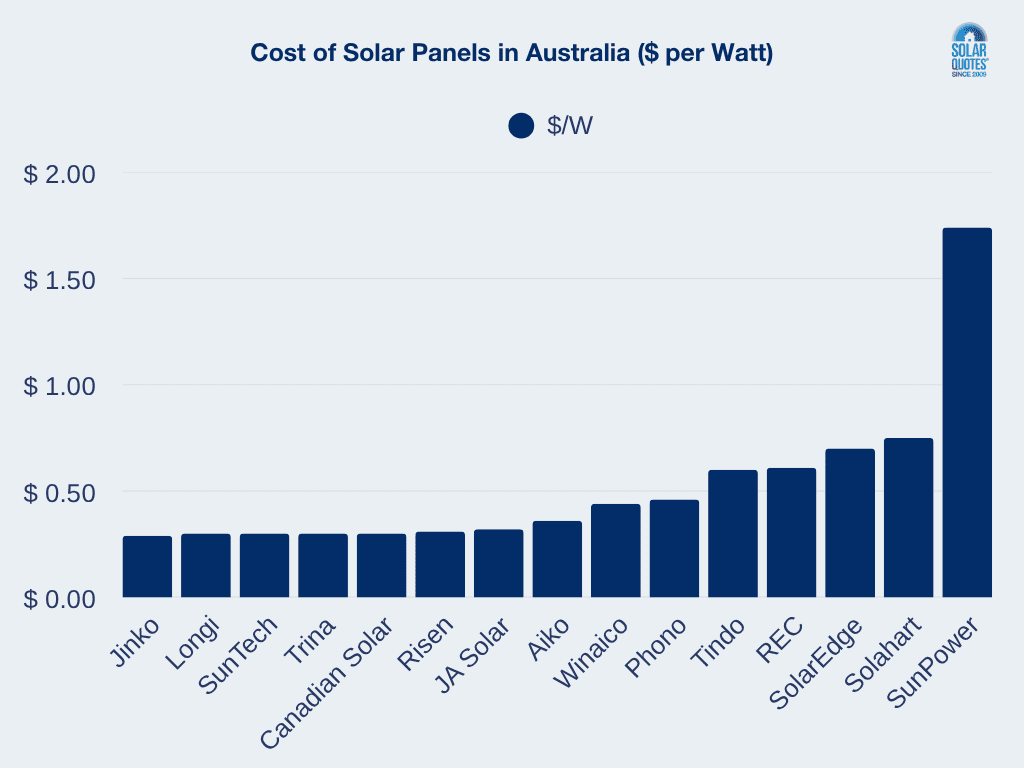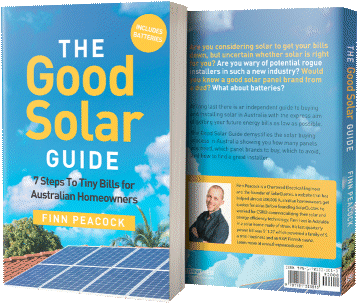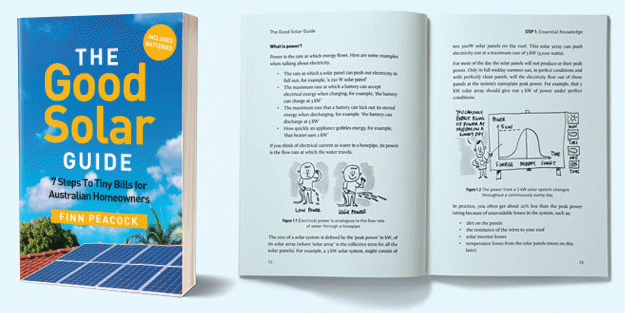
The sun appears to be setting on the premium offerings from high-end solar brands.
I’ve got top-of-the-range REC Alpha panels on my roof. I’m a solar snob.
Or at least, I was.
Back when I installed them, premium panels still made sense – kind of. They offered higher efficiency, lower degradation, better heat performance, longer warranties, and peace of mind that the brand would actually honour them. If your roof was small or shady, or if you just liked nice things, it wasn’t totally irrational to spend extra.
But something’s changed. Actually, a lot has.
Now, it appears REC is shifting focus to a new range of cheaper panels. SunPower – once the gold standard – has quietly dropped everything from our solar panel comparison table except their budget P7s and the mid-range Maxeon 3.
The message is clear: the market for premium panels in Australia is disappearing.
Update 23 May 2025: REC Australia have told me that they are not shifting focus to a new range of cheaper panels and that my source is wrong.
Mind The Cost Gap
And no wonder. The cost gap is enormous. A typical 10 kW system needs about 23 panels. Choose a solid budget brand like Jinko, and you’re looking at around $130 per panel. Go super premium – over $400 each. That’s a $6,000 difference for the same amount of electricity.
What are you really buying with that money?
A slightly slower rate of degradation, which might save you one panel in 25 years. Maybe a warranty that’s slightly more generous… but only if you can prove the failure meets their fine print.
Budget Brands Lifting Their Game
Meanwhile, the budget brands have lifted their game. Jinko, Trina, LONGi. These aren’t no-name panels. They’re backed by massive companies, come with 25-year warranties, and are installed every day by some of the best installers in the country.
A budget brand even won our 2025 Installers Choice Awards for best solar panels.
In 2025, there’s simply no reason to spend double or triple per panel just for a badge.
Unless you’re trying to impress other solar snobs at a dinner party.
Premium panels aren’t just overpriced. They’re disappearing. The brands know it. The installers know it. And increasingly, the buyers know it too.
So yes, I’ve got top-of-the-range solar panels on my roof. They’ve been great. But if I were buying today?
I’d put that extra $6,000 toward an extra 12 kWh of battery thanks to the battery rebate.


 RSS - Posts
RSS - Posts



Yep that’s happened to me, paid extra for premium LG panels in 2019, only to have LG announce that are stopping panel manufacturing.
When I decided I needed an additional system in 2023, went with what I considered mid range QCells panels, again they now don’t sell in Australia.
Even way back in 2010 had a tiny 1.5 lw system out on, and though Sharp was a good brand, think they are gone too.
I don’t have any plans to add more solar, so the manufacturers are safe for now.
On the strength of this site and Finn Peacock I installed my first batch of rooftop solar in August 2011. Every year since I have been told I need to spend yet more money to actually maintain the deal I signed up for back then in 2011. For 6 years it was buy yet more panels to offset the increase in kw buy price. Then when I eventually relented and did that, I lost my generous feed-in tariff. Since 2020 I am told I need to install a battery to take advantage of the thing I can’t control…..the ever increasing Kw buy price!
And you can see it standing out like dogs balls, the next hit will be the government will tax what power we feed into our batteries. Solar is a no win situation for the consumer. Every year the goal posts keep shifting to make sure we are never going to be ahead.
If I had my time over again I would put that money I have spent into making my property more energy efficient, Double glazing, added insulation. Something I know would remain effective year after year.
Double glazing provides a minor energy efficiency upgrade, but the real benefit is comfort and lack of moisture/condensation.
We installed a premium LG/Solaredge 7.68kW PV solar system at Oct 2017 -> calculated payback was 2022 (5 years), but when we bought our EV at end of 2019 (Dec 30 pickup), it sucked down most of the spare solar at a time when FITs were starting to drop, and this improved the payback to less than 4 years.
At that time, the LG panels were a massive improvement with wiring arrangement that effectively increased busbar from 5 to 12-16 (forgotten which), and providing a 20-25% capacity increase over the budget brands.
With Topcon/Perc/Half-Cut cells, the budget brands have caught up to the premium brands in performance, and it’s hard to recommend premium panels now.
Definitely a problem – 2 million homes in Vic to get off gas!
$2k annual savings according to solar Vic ….
Hi, I have just received a quote for what was said to be a top quality system. 16 Sunpower performance 7dc black panels,(claimed to be the best), SolarEdge inverter and 9.7 kw battery. Is this now not a good value system?
Another quote was for Aiko/Sigenergy combo and another was Canadian/Fronius/BYD combo.
Any thoughts appreciated.
Hi Pat,
I’d use Fronius but there’s horses for courses. Perhaps try the SolarQuotes reviews and sort for 1 star results?
https://www.solarquotes.com.au/inverters/fronius-review.html?period=6m
https://www.solarquotes.com.au/inverters/solaredge-review.html
> Solar is a no win situation for the consumer
I have a 10kw battery and 6.6kw of solar
I’m in Queensland so combined with state Labors $1000 electricity rebate + $300 federal labor rebate + $150 new federal labor rebate, I haven’t paid for electricity since July last year and won’t until like 2027
My last electricity bill: $10.03, one before that $12.31, one before that $4.40
I also have a cheap second hand EV and fill it up with solar power, so that’s saving me $ every week as well
I think the battery might be the thing you’ve been missing the whole time, the only thing to worry about then is the daily charge and making sure you don’t use more than what’s stored in the battery overnight
strange, I see it the oposite way and this site helped me to that view both through information as well as good installers and great products.
In 2020 we forked out for 7.8kW of LG’s second best pannels at thebtime (sales propaganda said so) with Enphase micros given shading was a thing on string inverters at the time. This paid for itself exactly as the calculator on this site suggested in 4.5 years given the, back then, higher pricing. Still running as new btw, no issues.
I again ran the numbers and then through the battery calculator here. Got 1 tesla Pw2 and a year later seing the benefits got a second. First will pay for itself under 5y. The second should 2y before the warranty unless pricess drop per kW (unlikely).
For me, even the whole house backup/UPS function is tested often and is priceless on its own.
And yes, an EV is on the way.
No regrets. None of my work colleagues or family have regreats either.
The solar panel manufacturers need to start providing more efficient panels – panels that are 1m square, to make more efficient use of hip roof faces, and to better provide for existing protrusions on roof faces. Such panels should also be easier to handle for installers.
And, the solar panel manufacturers should become innovative and creative, and, manufacture and supply triangular panels, such as the 1m square panels, halved diagonally, to increase efficiency even more, of solar panel generating capacity on hip roof faces.
Maybe, with increasing competition, the existing solar panel manufacturers will take off their blinkers, and start being innovative and creative.
Otherwise, if some radical solar panel manufacturer startup, starts producing these two forms of 1m based solar panels, and no-one else does it, then, the established panel manufacturers will likely go the way that is predicted for the ICE vehicle manufacturers – dinosaurs falling in tar pits.
Big names die.
Panels cost $0.20c a watt.
People selling them for double that are screwed.
Still need something to attach then to and AS1170.2 says that you need more fixings at the end 1/3s of the roof as uplift forces are greater.
It’s also not practical to work near those edges as you need edge protection which often bolts to the roof around the edges and makes putting panels there at the same time impossible.
Nothing is ever easy!
Karl Jensen (I was at secondary school with a student named Karl Jensen – he rode a Laverda motorcycle) – my understanding is that the panels can safely, and in accordance with regulations, go to eight inches from the ridging; the person with whom I dealt, regarding our current system, told me that a good rule of thumb, is one tile width from the ridging.
The smaller the two dimensional dimensions of panels, the more efficient they can become, in terms of generating capacity relative to the area of the roof faces, especially on hip roofs.
And, I believe that what I specified above, would be the optimum.
Tindo is an Australian manufacturer of solar panels. Now, if they (in the absence of any other solar panel manufacturer being interested in doing it), would do some market research, and, find what proportion of houses in Australia, have hip roofs, with a view to implementing my above suggestion about the one metre panels, and, then, get federal Made In Oz funding to do it…
What drew me to REC Alpha Pure 420W was that they are Pb-free. My only water supplies are off the roof, or out of a dam. I did approach the solar panel mob in Adelaide, but they were totally unable to answer the incredibly complex question “Are your panels lead free?” Instead they replied with a query about roof dimensions & contact for quoting – an incompetent formulaic response, which ended interaction.
Just as gas combustion products are carcinogenic and asthma inducing, lead also causes cancer and reduced IQ, especially in growing brains.
It may be that they all have to be lead free by now, but it needs to be declared to compete.
We’ve had a stand alone power system operating since 2003, and seven years ago, installed a new set of 24 – 1800Ah lead acid cells on the assumption that the original set was very soon to fail due to aging – even though the system overall was still working fine at the time of the new install.
We anticipate having to replace this second set in a few years’ time, but due to the exorbitant cost of replacing lead acid batteries, we were considering changing over to the new type of batteries currently on the market in an effort to reduce the cost of doing so.
We have been informed that if we do this, our system will require a substantial upgrade and new rewiring to accommodate the same.
Can you advise if any of this advice is true?
Warren H
Hi Warren,
2003 vintage off grid system components are likely to be very basic compared to the current generation.
You might be able to use some “unmanaged” batteries like Zenarji or PowerPlus as they don’t need the inverter to communicate to them.
However I’ve seen first hand where modern lithium batteries perform so well, they are so stiff in terms of voltage delivery, the legacy system, particularly the generator auto start control, is so confused it becomes useless.
Lead acid has some sag, a gentle voltage slope as they discharge.
They also have a lot of spare capacity (or autonomy) in case of emergency.
Contact us for more advice if you need.
While I fear like you may be right about the premium options disappearing from the Australian market, it does leave me concerned that there will be limited or no fit for purpose options under the following circumstances:
1. Regular strong partial shading situations where you don’t want hot-spot risk (and consequent damage to panel or even fire risk). The Maxeon technology seems to be the ultimate “safe” solution for this (virtually hot-spot immune).
2. High wind load installs – especially short-edge fixed. Very few of the common panels being installed have suitable strength for anything atypical. Premium panels are typically significantly higher rated.
This is not surprising because as solar is now mainstream the big reputable manufacturers are all into it and with mass production and the latest technology panel prices will fall while quality increases.
The same thing is happening with batteries and inverters so generally anything from established manufacturers is likely to be good quality whatever the price.
That just leaves the design and workmanship of the actual installation as the major factor in the performance and reliability of a system.
Sounds like common sense to me!
Aiko is the best in town with 23.8% efficiency. Jinko and Trina etc should have panels to catch up to them in the next 3 months …. waiting.
Do you think this will also be true for inverters in the future?
I had a 12.8kW system put in in l2022 using Jinko 66TR, 415W panels. They have efficiency at 21.74% with a 25-year product guarantee and an 87% @30-years power guarantee. So far, very happy.
Hi I had Sunpower Maxeon 6. 39 panels installelled with Enphase iq7a micro inverters. As the installer said these panels are the Ferrari of panels. Should not have fallen for that LINE. Should have gone with any of the other brands and saved at least 6 to 7 Grand Regards Hans.